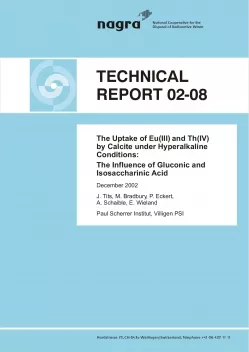
Technical Report NTB 02-08
The Uptake of Eu(III) and Th(IV) by Calcite under Hyperalkaline Conditions: The Influence of Gluconic and Isosaccharinic Acid
Calcite is an important component of Valanginian marl, a potential host rock for a low and intermediate level radioactive waste (UILW) repository in Switzerland. This mineral also forms an important component of the disturbed zone around a repository, as it remains largely unaffected by the hyperalkaline waters migrating out of the cementitious repository.
The sorption behaviour of Eu(lIl) and Th(IV) on Merck calcite in an artificial cement pore water (ACW) at pH 13.3 has been studied in batch-type sorption experiments. In addition, the effect of α-isosaccharinic acid (ISA) and gluconic acid (GLU) on the sorption of these two cations has been investigated.
In the absence of ISA and GLU, a strong interaction of Eu(lIl) and Th(IV) with Merck calcite was observed. Eu(lll) and Th(IV) sorption kinetics were fast and the isotherms indicated a linear adsorption behaviour over the experimentally accessible concentration range. In the case of Eu(III), a decrease of the Rd value with increasing solid to liquid (S:L) ratio was observed indicating that, along with adsorption, other processes might influence the immobilisation of this cation by Merck calcite under ACW conditions. In the case of Th(IV), however, changes in the S:L ratio had no effect on the sorption behaviour.
High ISA and GLU concentrations in solution significantly affected the sorption of both Eu(lIl) and Th(IV): Rd values for Eu(lIl) decreased significantly at ISA concentrations higher than 10-5 M and at GLU concentrations higher than 10-7 M. The sorption of Th(IV) was reduced at ISA concentrations above 2·10-5 M and at GLU concentrations above 10-6 M.
The effects of ISA and GLU on the immobilisation of Eu(lIl) and Th(IV) were interpreted in terms of complex formation in solution. In the case of Eu(lIl) the metaIligand complexes were found to have a 1:1 stoichiometry. Complexation constants derived for the aqueous Eu(III)-ISA' and Eu(III)-GLU complexes were determined to be logß0EuISA = -31.1±0.2 and logß0EuGLU = -28.7±0.1.
In the case of Th(IV) it was assumed that a Th(IV) - ISA - Ca complex and a Th(IV) GLU - Ca complex were formed both having a 1:2:1 stoichiometry. The complexation constants for these two complexes were determined to be logß0ThISA = -5.0±0.3 and logß0ThGLU = -2.14±0.01 .
Assuming that the concentrations of ISA and GLU in the pore water of the disturbed zone are similar to the maximum concentrations estimated for the cement pore water in the near-field of the repository, i.e. 10-5 M ISA and 10-7 M GLU, then the formation of aqueous complexes with ISA or GLU would not significantly affect Eu(lIl) and Th(IV) sorption on calcite.
